Stryd Duo + Stryd Footpath ($299 for 2 pods plus $9.99 per month for 12 months)
Introduction
Mike P: Since receiving the Next Gen Stryd pod last year, it has become an essential piece of my running gear. At this point I wouldn’t think of going out for a run without it! After using it through a full season of training and racing, I can definitively say - I’m a converted “power” runner.
When I heard about the “Duo” pod setup from Stryd, I immediately reached out to see if we would be able to test. The idea alone - of having a pod on each foot, rather than just a single
pod - just seems intuitively more accurate in terms of all the metrics and features that Stryd already provides. Not to mention the new dual-pod based metrics and features!
But the real WOW factor that caught my attention was definitely the Footpath visualization - A full top/side/rear visualization of the path of each foot throughout your running “Stryd”. I’d never hear of anything on the market that provides this feature - outside of going to a running shop and doing some type of video-based gait analysis. Now you have the ability to record and analyze your footpath during every run in every type of terrain ?!?! Just think about that for a minute.. Isn’t technology amazing? But does this really work - and furthermore, is it really of any use other than looking very cool? We’ll see..

[In the box]
Features and Tech
If you’re new to Stryd, running foot pods in general, or using power as a running metric in general, I strongly urge you to go back and read our full Next Gen Stryd pod review from last year.
In this Stryd Duo review, I won’t go back and rehash all the benefits of using the (single) Stryd pod. You can go back and get all the details in our previous review. But I’ll quickly recap and highlight some main points before I dig into the new Duo features.
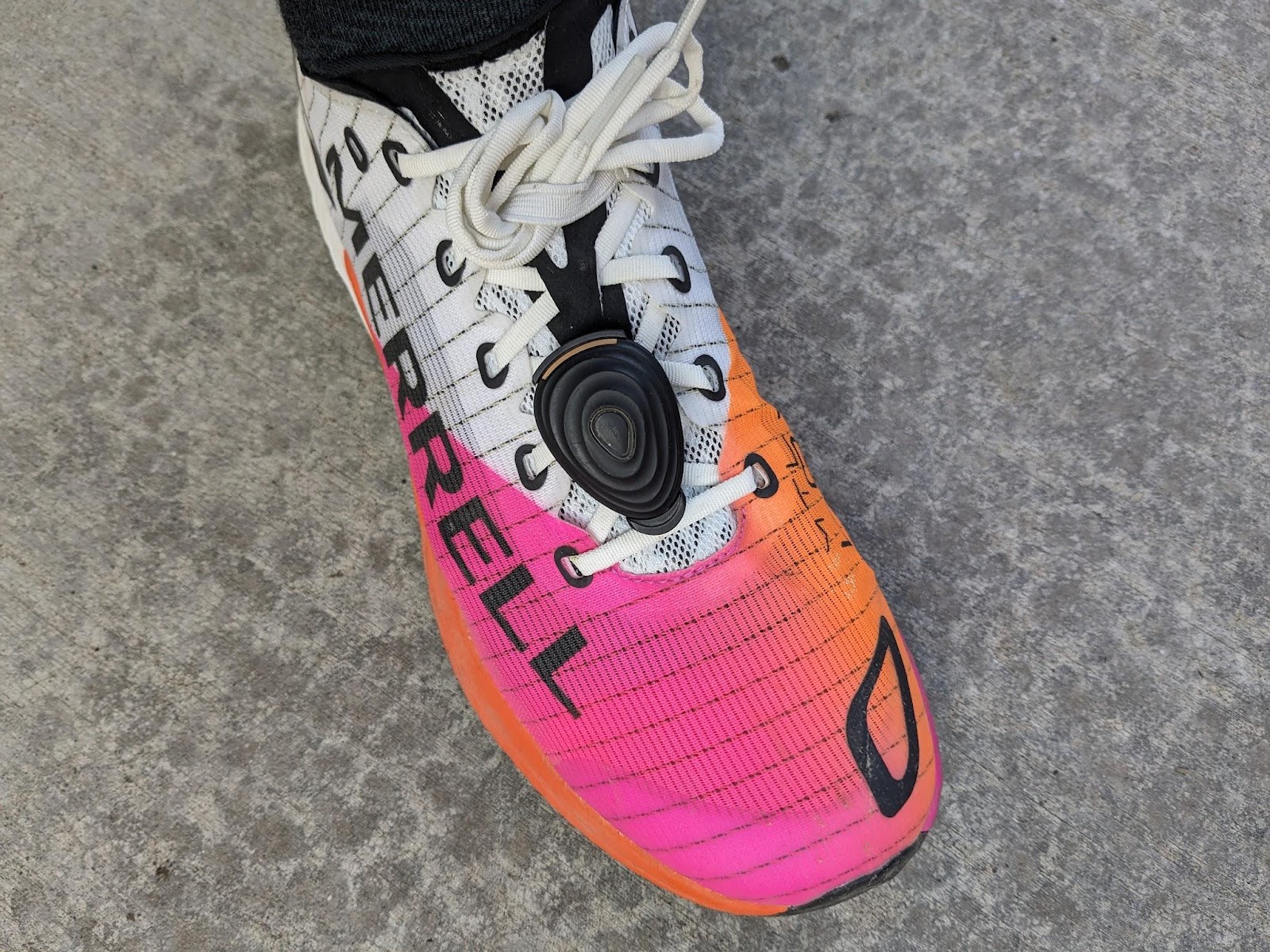
Distance and Elevation - This has been a complete game changer for me. The Stryd pod provides more accurate distance and elevation than any GPS watch can. I have validated this throughout a full year of testing. Key points - you do not have to wait for your watch to acquire a GPS signal before starting a run, and you don’t have to worry about signal drops messing up your data. You can turn off your GPS altogether in order to save battery on your watch. I did this exactly during a recent backyard ultra - I left my GPS on for the first few laps or so - just so I can see the course route in Garmin. But after that I completely turned off my GPS since I was running the same track every loop. With my Stryd pods, I got laps within hundredths of a mile over the course of 36 hours. Check my power data from the Dizzy Horse Backyard Ultra here -

[I got loop distances between 4.13 and 4.17 for the entire 36 hours - via Stryd, no GPS. I had some trouble keeping up with the charging in the final laps - that’s why I lost balance metrics. But I kept a single pod going, and it didn’t mess up the recorded activity in any way.]
Running with Power - Quoting from my previous review - “provides steady, accurate, real-time data on the run.” As a trail runner this has been invaluable as I run over a wide range of terrain and conditions. Pace can be useless at times on the trails, especially in very steep terrain. Heart Rate is generally ok to gauge effort, but there is an element of lag, and also signal drops, especially in cold and/or dry weather. Power is much more reliable over the course of any distance and duration to gauge your pacing, output, and effort. I won’t get into the nuts and bolts of Critical Power and determining your power zones, etc. - that is extensively covered in our previous review.
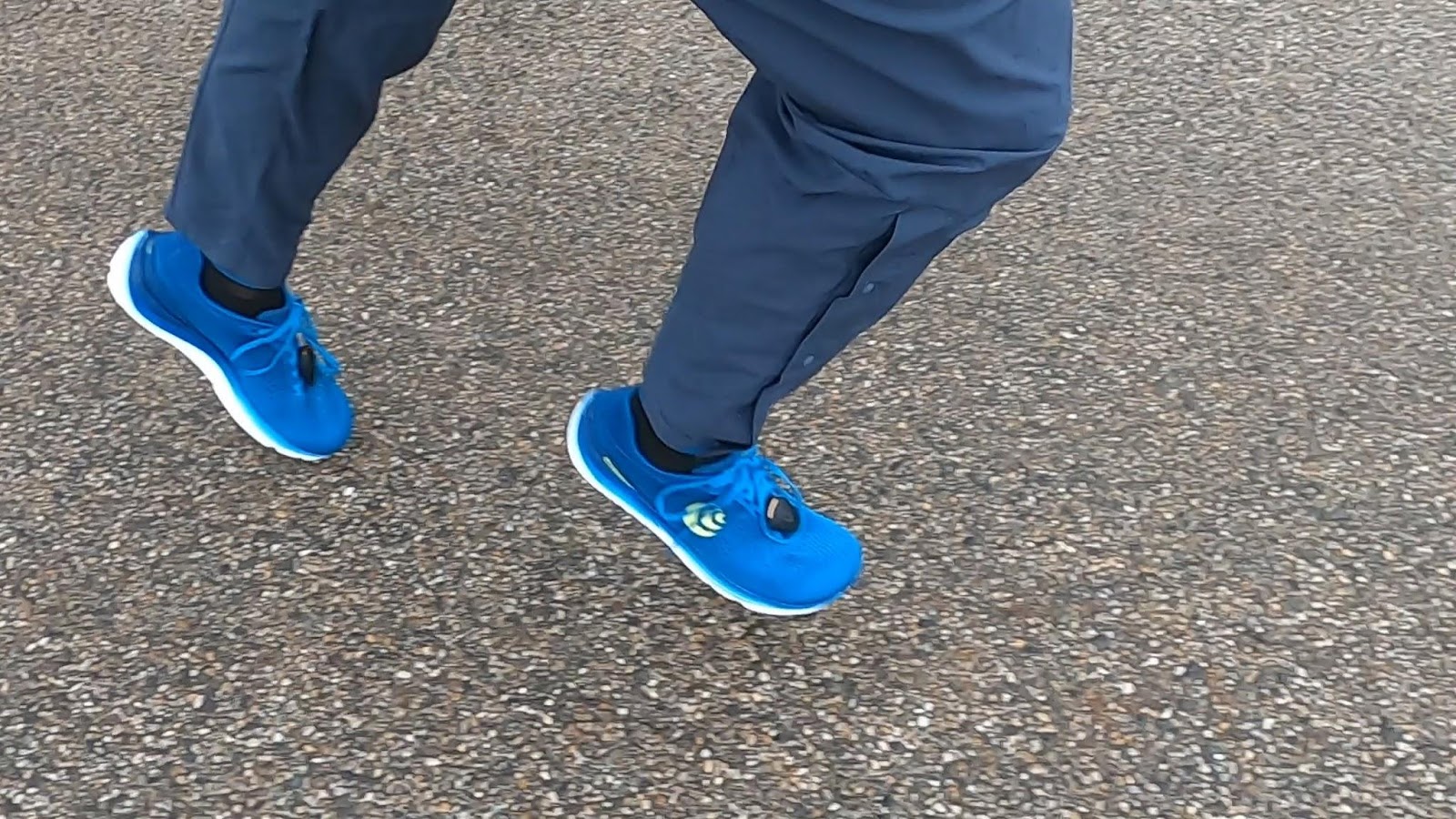
Power-based metrics include: Pace, Distance, Time, Elevation, Cadence, Form Power, Ground Contact Time, Leg Spring Stiffness, Vertical Oscillation, Air Power, and Impact Loading Rate. Several of these metrics have been further enhanced by having a second pod - essentially so you can gauge the balance between the left and right legs. We’ll dig into those later.
To be honest, over the course of a full year+ with the pod, I don’t pay too much attention to these metrics in their own right. I get so much value from the basic Power value (watts) itself, that I don’t see the need to spend time or energy worrying about any other specific metric. But the data is there, if you are so inclined to dig deep. But does having a Left/Right ratio for some of those metrics change my opinion about using them???
Michael: I’ve long attested that Stryd is one of very few pieces of running gear that, if I lost today, I’d buy immediately. I’ve owned one for some 5 years now, and can count on one hand (okay, maybe two hands) the number of runs I’ve done in that time without at least one Stryd unit strapped to my shoes. But, then I always caveat that recommendation by saying that by far my most useful case for the footpod is treadmill running - where it’s hyper-accurate - and that is if you’re buying for “running with power” alone, then you really need to consider how you’d use that metric. I think there are still very compelling arguments to be made for this thing, but it’s less of a no-brainer.
Of course, in reality, there are plenty of other use cases than just treadmill or power-based-training; Stryd is extremely accurate outdoors, even compared to GPS, so urban runners benefit when buildings interfere with signals; you can use power as a metric to supplement your training, the same way many runners train with heart rate monitors; you can augment your training with non-power-based metrics as Mike describes above (cadence, ground contact time, etc.) which other companies implement into standalone devices… and now, the big one: Footpath Visualization. We’ll get into that in detail, of course, but in my opinion, Footpath Visualization and the Duo pod setup revitalizes Stryd, and reinforces that Stryd is one of the companies really fusing tech and running for the better (even if right now, it does feel a bit like we’re all beta testing - I have faith in this data-based company!).
Illustrations and discussion of data/output
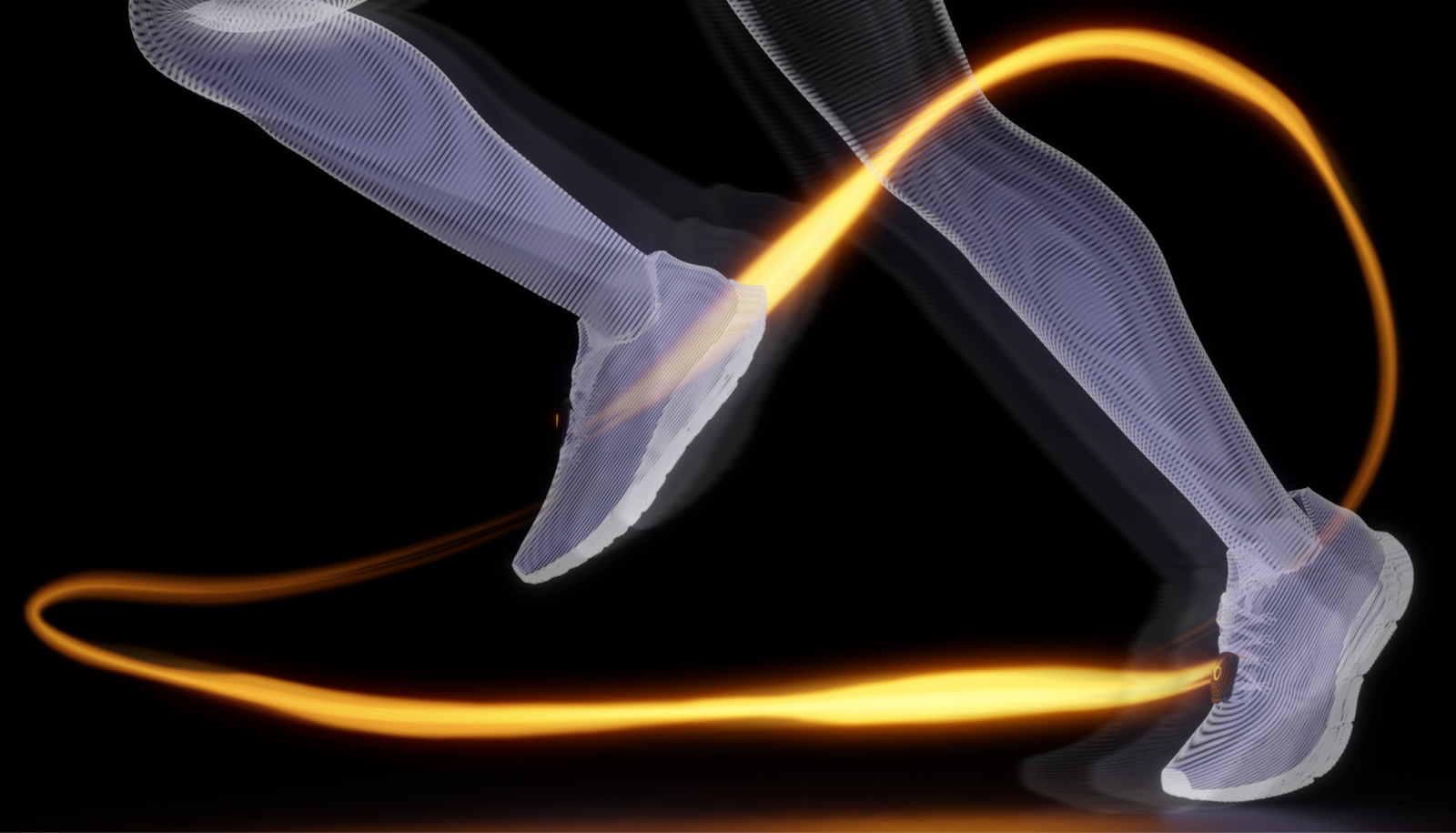
Mike P: Stryd provides a quite succinct summary of the new Duo Pod features here- I would read through that to just get the general idea about the Duo setup.
Essentially, in order to set up the “Duo” system, you need two separate Next Gen Stryd pods. If you have an existing Next Gen Pod, you can purchase one more, and the pods sync with each other to form the Duo pair. If you don’t have a Next Gen Pod, you need to purchase two Next Gen Pods to set up the Duo system. Stryd has offered some deals for purchasing an additional single pod to complete your Duo, or for buying both at once, and they did have some deals in conjunction with their membership plans. Check their website for their current offerings.
These are the new metrics provided in the Duo setup:
Ground Contact Time Balance
Vertical Ratio
Vertical Oscillation Balance
Leg Spring Stiffness Balance
Impact Loading Rate Balance
You’ll notice that they are essentially the same metrics provided by a single Next Gen Stryd pod. But now since you have separate metrics from two pods - one on each foot, you can compare one side to the other and see differences in how both sides of your “body” or “running stride” operate.
Now, you may find yourself asking - do those new metrics really provide any useful information? I can answer that two ways - I didn’t find too much value from the specific metrics provided by the Stryd pod. Many of the metrics are just that - measurements. Yes, they may have value in and of themselves, but at the end of the day - you can’t really do too much with them. For example, if your Vertical Oscillation shows a certain value, which maybe you think is too high or too low - is it at all possible or advisable to adjust your running to “fix” it?
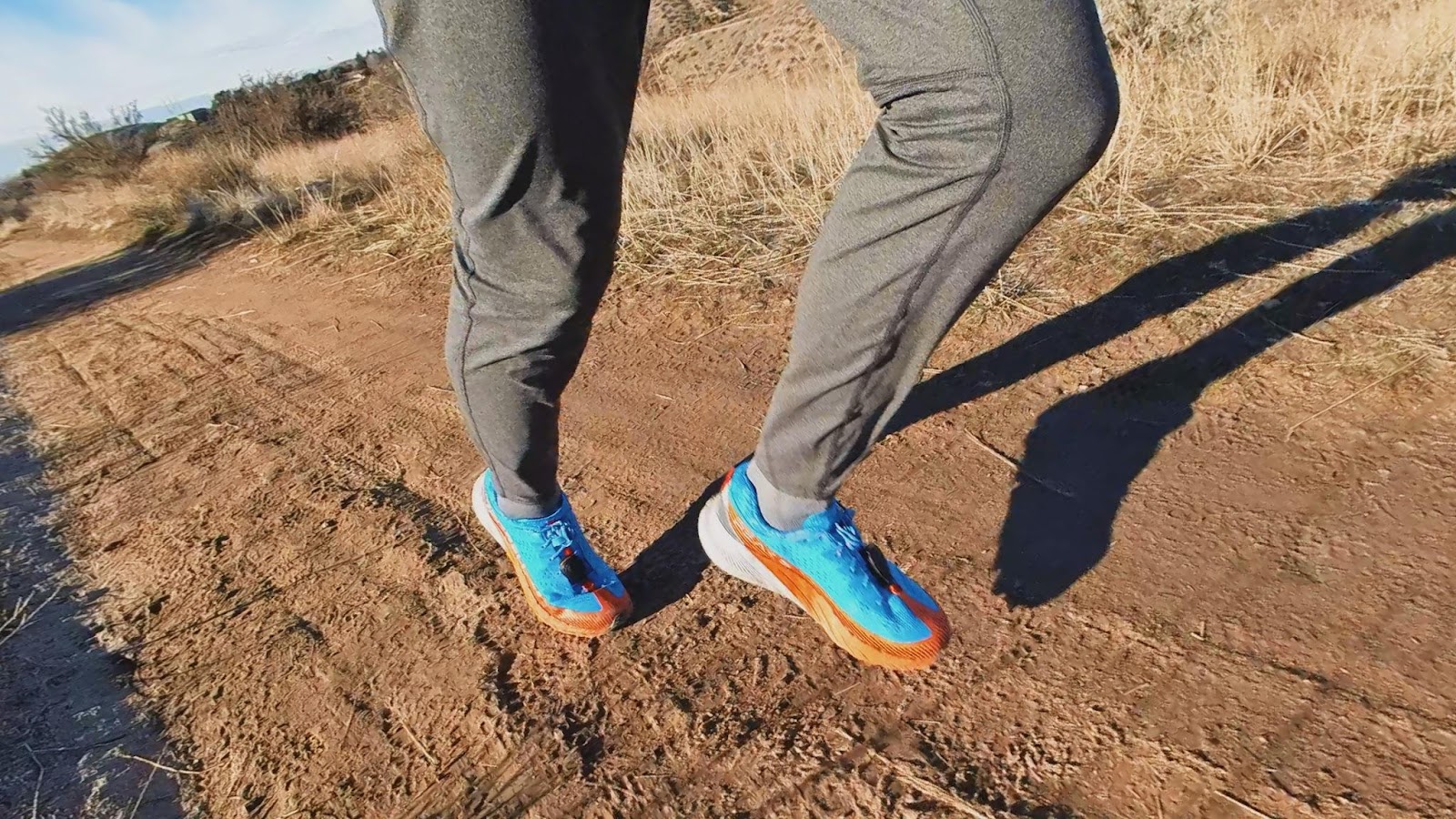
In fact, I’ve recently joined some of the Stryd Community groups and seen similar sentiments expressed there by both users and Stryd’s own moderators. Consciously adjusting or changing your stride in response to one or any number of these metrics is simply not a good idea. Furthermore, there are really no definitive guidelines or directions as far as moving any of the metrics in one direction or another, even if you were so inclined to try it.
So, in the end, if you think the value of the base metrics from a single Stryd pod are not super valuable, the Duo Pod may not change your mind. But on the other hand, the balance or ratio between the left/right sides may be another story.
Initially I noticed that my Ground Contact Time balance was a bit off - my right side being lower, or having slightly longer ground contact time than my left side.
As runners, it’s likely a good idea to strive for symmetry in our running stride, so naturally I tried various methods of “evening” out or getting my GCT to an even 50/50. Those included - trying to pick up my right leg quicker, trying to push more into the ground with my left leg, trying to put more force and “bounce” more off my right leg.
This was interesting initially, as some methods worked more than others at times, and I could watch the GCT value in real-time on my watch (you can see the value in Garmin’s native GCT data field/gauge). But it just became tedious, and pretty annoying to run in that way. Also, terrain factors became apparent - as I was running on trails most of the time. For example, when running on a trail cut along the side of a hill, the trail likely slopes every so slightly downhill. I noticed this would throw off the GCT numbers right away, and made me think that anything other than a flat, even trail would also likely throw “off” most, if not all, of the metrics when trail running.

So in the end, I resolved to focus on single-leg strength work to even out any imbalances that I may have. This would likely provide the most bang for the training “buck” if you generally want to be a stronger and more balanced, or “symmetric” runner. Monitoring the advanced metrics after the fact or even in real-time just feels like more of a time suck than anything else.
One area that may be of interest is in the case of injuries. That was one area that I noticed being mentioned in Stryd forums and webinars as a usage scenario. If you at least have a rough gauge of your metrics when healthy, the idea is that - perhaps you would notice if values begin to change as an indicator of some type of injury or fatigue coming on. Of course if you are actively running with an injury, I would imagine the numbers would be way off from your baseline.
I didn’t come in/out of any injury periods during my testing, so I can’t comment too much about this. But this does sound like a useful scenario to me- not worrying too much about the actual values of the metrics themselves, but paying more attention to the relative changes during certain periods. I know one of our testers - Joost has been dealing with some injuries, so he may have some better insights on this.
Performance Personal Utility
Mike P: Here’s another quote from Stryd’s description article-
“Stryd Duo also comes with additional accuracy benefits over the Next Gen Stryd, such as increased data stability without sacrificing responsiveness for existing Stryd power metrics, such as Stryd Power, Form Power and Air Power.”
If one pod is good, two pods is better right? At least in the sense of being more accurate. This makes perfect sense to me, and honestly, I do take this claim at face value. I found the single Stryd pod to be exceptionally accurate, so I could absolutely see the data being enhanced or refined based on collecting essentially double the amount of data. For a simplistic example - if Pod 1 calculates X distance, and Pod 2 calculates Y distance, I’m sure the average of the 2 will be more accurate over the long run.
I mentioned GCT Balance as a metric that I noticed initially during my testing. This was never a feature that I had access to before, so it was completely new to me. I assumed that it was something that would naturally depend on having some type of dual foot pod setup. But then I did some research and found out that Garmin has a HR monitor strap that also provides this metric.
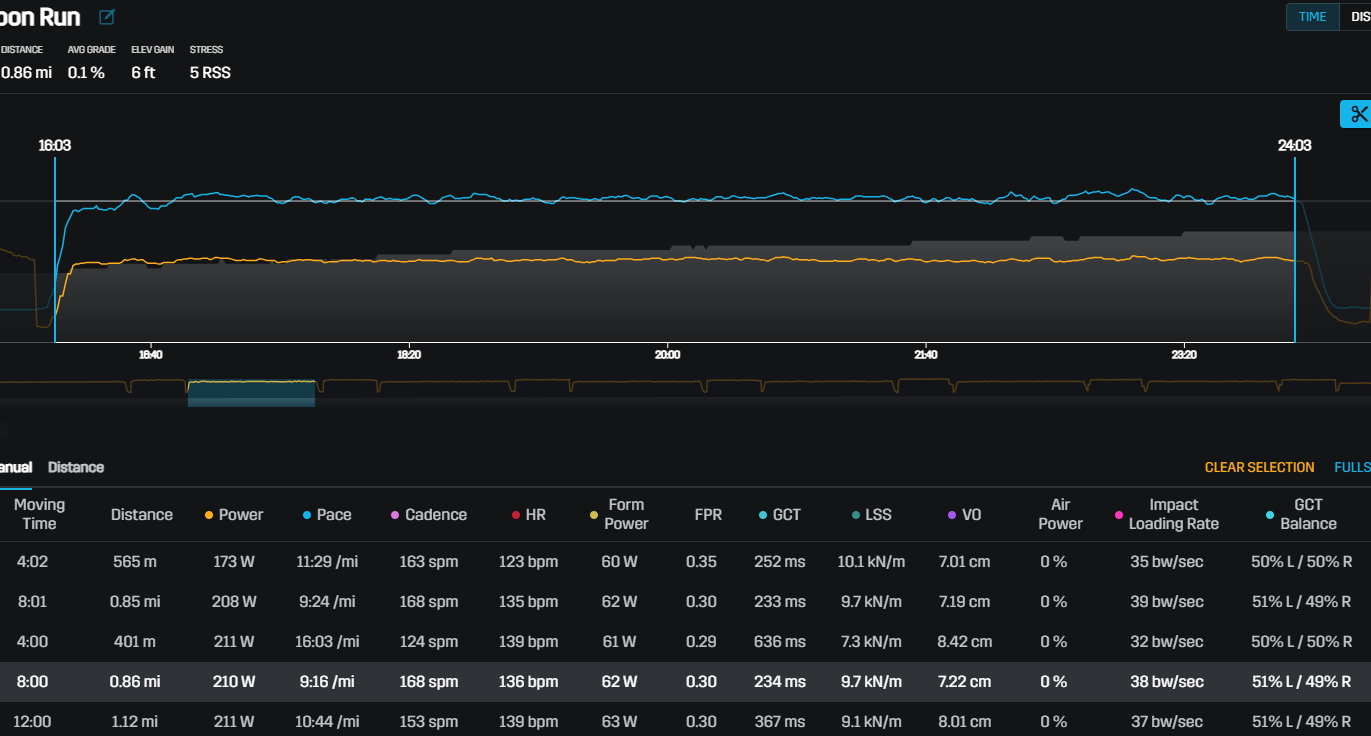
Now, I have no experience with using that specific tool, but pulling the thread of data accuracy here - I can’t imagine that getting “balance” values from a monitor in the middle of your chest could possibly be more accurate than measuring from separate devices on each foot. Furthermore, I actually wear my HRM monitor strap slightly off to the right side, as it gives me a more consistent reading. I know some athletes wear them off to the side for that same reason. Ultimately, the increased data accuracy claims for the Stryd Duo setup, specifically for any type of ratio/balance metrics, just make sense to me from a purely logical standpoint.
Footpath Analysis
Mike P: Now, to the fun stuff. It’s super interesting to be able to view your footpath after each run! Your reaction to seeing this visualization could range from anywhere to pleasantly surprised, to confused, or even shocked and appalled! Just kidding.. Or maybe now. I’ve seen some pretty interesting footpaths posted to the Stryd FB Community groups.
As I’m working on this review, Stryd just announced the latest feature update 3D Visualization. Up until now, you’ve been able to view the footpath only in a 2D range from 3 different perspectives: side, top, and rear. Here is a view of the new 3D view, from a left/rear/top perspective (the following screenshots are from a treadmill run):

[Orange - left pod/foot, Blue - right pod/foot]
Honestly, this is simply amazing. You can use the mouse to grab and rotate the diagram in any direction. I find this new view much easier to “visualize” - as in - mentally following the path of each foot then in motion. Previously, with only the 2D views, it was sometimes confusing to get a handle on which direction your foot was traveling in. I.e. which was the forwards stride vs. the backward stride. This 3D view now eliminates that confusion as you can quickly drag and drop to view different angles and get a better sense of your footpath in “space”.
My footpath analysis - higher right leg kick back
Something I noticed right away from the footpath was that I tend to have a higher kick-back with my right leg. This was noticeable across all runs, and easier to key in on when looking at treadmill runs, since the surface is obviously regular the entire time. I have to say that, when looking at the 2D view, it didn’t seem like too much of a difference.
But now in the 3D view it looks much more substantial and has me wondering more if this is something I should “work on”.

[3D - from the rear]
I put “work on” in quotes because even with all of these metrics, and visualization, it’s still not clear if any difference you may have are just natural variations - that are “fine” and “normal”, or something that perhaps could be “worked on”, “fixed”, or “balanced”. Again - everything in quotes here, because in most cases, I’d say these are unanswerable questions.
When looking at my left/right footpath in the 3D view, these are the points of analysis that strike me, in no particular order-
3D visualization in relation to metrics
I talked a little bit earlier about noticing my Ground Contact Time (GCT) Balance being somewhat off. Those metrics showed that I spend more contact time on my left foot. I also mentioned how I was more or less “shooting in the dark” as far as what to do with those numbers, and how I could possibly affect them. I even tried running in certain ways to see if anything changed, but it was all pretty much just guessing.
Now with the 3D analysis, it’s much easier to think of those numbers in relation to your actual recorded foot stride.
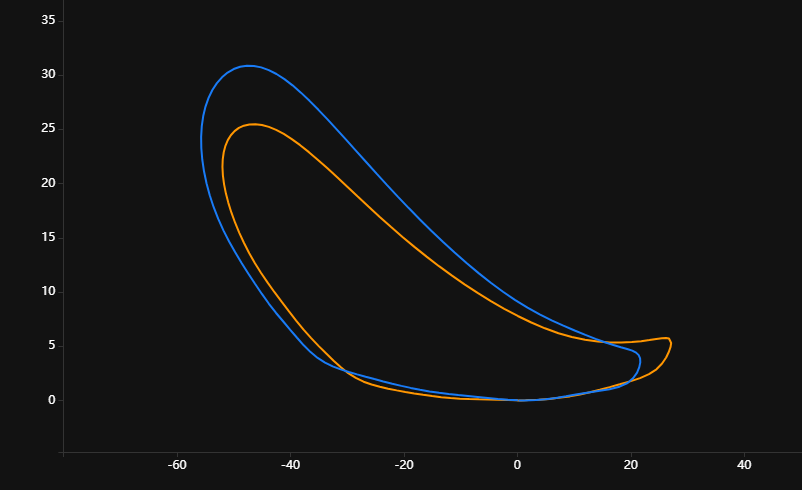
[Orange - left pod/foot, Blue - right pod/foot]
Looking at the side view above, it seems as if my left leg is extending more, likely leading to the longer GCT. Now does this mean I am possibly overstriding on my left side, or is my right sight lacking mobility or extension? I don’t know, but it’s definitely something to think about and possibly analyze further rather than just guessing based on the metrics.
Now that I can see that my left stride seems marginally longer, at least visually, and as measured by the GCT metric - does it make sense that my right leg has to kick back higher in order to return “quicker” in order to “catch up” in a sense? Again, I don’t know the answer to this.
Relationship to my personal injury history, perception of weakness/balance
I’ve tended to have more issues on my right side/leg in the past. I had an Achilles injury when I first started running as well as ITB issues. These days I typically feel more hamstring tightness specifically on the right side. Also, I always felt that my right ankle is a bit weaker, tending to need more support at times. This is quite apparent through testing so many shoes with varying levels of underfoot support.
Does this perception, or actual, imbalance show in the metrics/visualization? I’m a little bit surprised that the most noticeable thing in my footpath is the higher leg kick from my right leg. It seems counterintuitive to me, but perhaps it’s an overcompensation thing based on my right leg providing relatively less power than my left?
Lifetime sports history
Where do our imbalances come from? Are they something that crops up over time - specific to running, or something deeper, perhaps rooted in our personal movement history, maybe even other sports and activities that we’ve done in our life.
For me - I spent the vast majority of my younger years as an inline speedskater. This was from my early childhood through adulthood. I primarily “trained” (this was the 90s) and raced indoors - think short track ice skating, but on inline skates. This meant a lot of left turns. In the indoor version of the sport, you’re pretty much coasting the straights, and powering through the turns - primarily using the inside (left) leg to push through and back as you cross over with the right leg.
I have no doubts that this background greatly contributes to my sense that I may have some type of imbalance between my legs. Perhaps you have some type of background - athletic or otherwise - that now influences your running mechanics?
Natural imbalances
Along the same lines as a specific sporting and/or injury history - there are some imbalances that are just natural. Most people tend to favor one side or the other, without thinking about it. If you just happen to be standing around - notice if you begin to stiffen one leg another, and kind of “post up” on it, rather than standing on both legs equally. Most people do - I know that I tend to lean on my left leg. Now extrapolate things like that across your lifetime. With that in mind, would you expect your running stride to be perfectly balanced?
Hiking
Interestingly, here are some 2D visualizations from treadmill hiking. Here my left leg swings slightly higher in the rear, and seems to remain higher as the leg swings forward before dropping down.
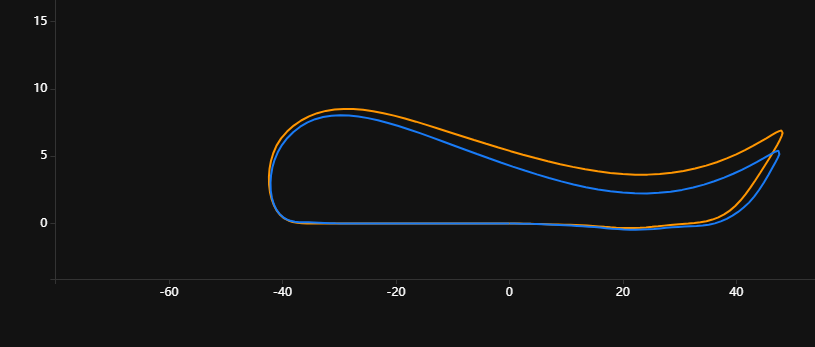
[Side view - hiking, on a treadmill: left leg orange]
In the screenshot below, see how the left leg swings higher in the back, which is opposite to what happens when running. This was something I looked into and also read about in the forums. You may notice big differences in your stride pattern at different running speeds, going uphill/downhill, and of course hiking or walking.
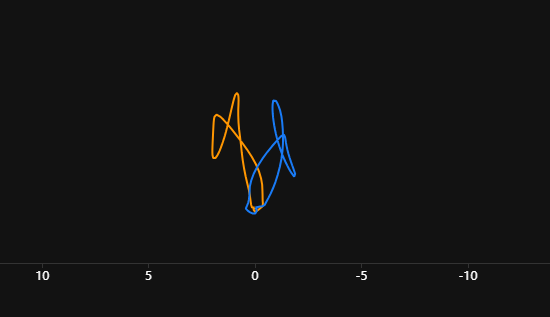
[Rear view - hiking, on a treadmill]
Also notice how the 2D view is very difficult to visualize. Now with 3D enabled, once you start panning around, in a few seconds the visualization “clicks” and you get a sense of it much more easily.
Inclines/Descents
The visualization is also useful for analyzing inclines vs. descents, which is specifically pertinent I’d say for trail runners. The screenshots below show a climbing segment on a semi-steep dirt road, followed by the descent of the same segment later on in the run. I found my left/right discrepancy to be less noticeable on trails, and less prominent at slower speeds, which makes sense.
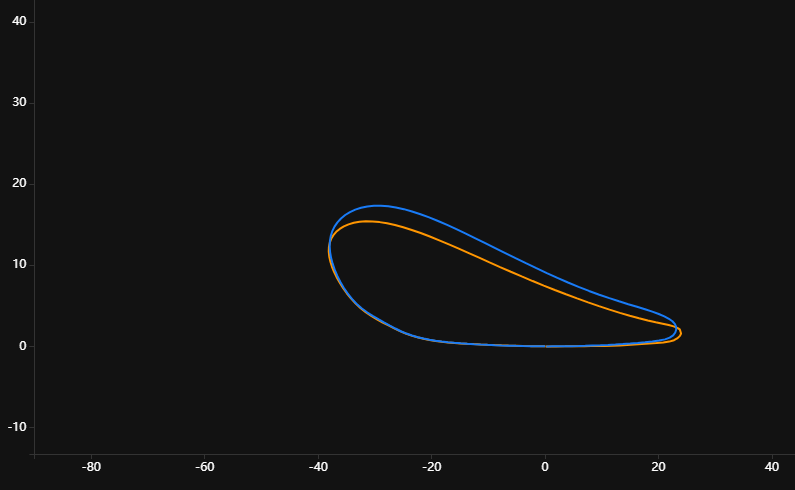
[5:00, 0.5M uphill, on trail, 11% grade]
I also found not much of a relative difference for me (aside from the higher R leg kick) between going uphill and downhill. It’s quite interesting to see here how my landings seem to be very balanced between the left and right sides. I don’t see the relative “overextension” or my left stride which was so apparent on the treadmill.
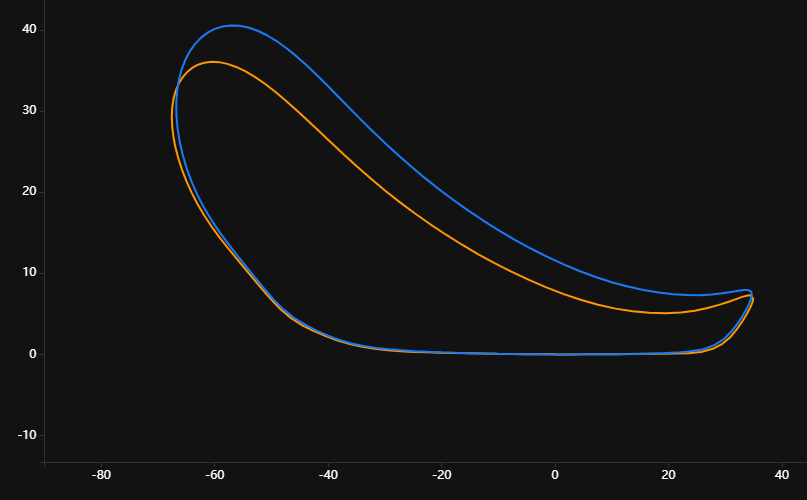
[Same section as above - the descent]
You can also see how the uphill stride is much shorter and shallower, than the longer and faster downhill stride. The screenshots are at the same scale. Pretty cool !
Video
Just for reference, below is a screenshot from a pretty regular, flat road run. Again, similar to my treadmill run, the longer left stride is again more apparent than during my trail runs. Does this just show inherent differences between trail and road running? Does trail running make you a more “balanced” runner = ) ? Are my mechanics quite different between road and trail?
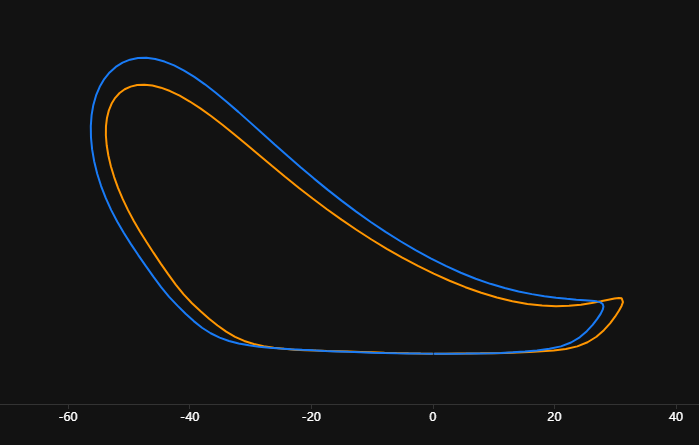
[A regular, flat, road run]
Still, the treadmill incline issue
The biggest missing link in using the Stryd pod is capturing incline when using a treadmill. I discussed this in our original review - currently there is no good way to capture/input the incline setting of your treadmill. This is of particular annoyance to me, as treadmill hiking is a workout that I do quite often.
There are 2 options for this. One, using the Stryd app on the phone to record your workout - this allows you to manually input the incline within the app. This method has the issue that you don’t have the metrics you would normally have on your wrist with your watch. Heart Rate is the big one - if the app could just record heart rate into the activity, this would be a much more usable option.
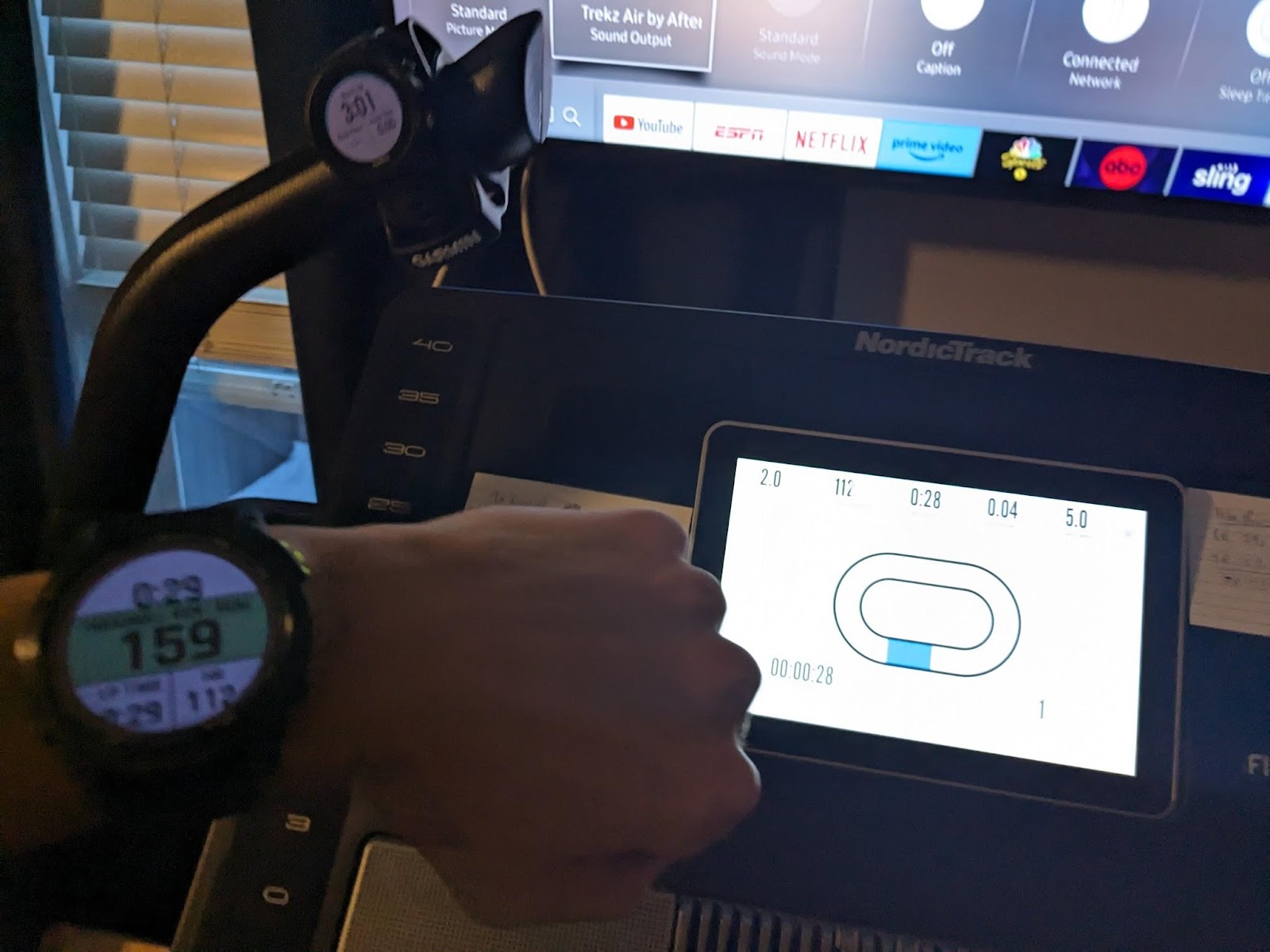
[Treadmill setup, for now, capturing incline is still a pain]
The second option is to use the Stryd Workout app on Garmin watches. This app is actually being sunsetted, and will no longer be supported. But it still works. You can enter the incline using your watch buttons (or touchscreen) on one of the app’s data screens, and power is adjusted accordingly. This is also a little bit cumbersome because I typically set up my workouts in Garmin and there is no way to make those work together with the Stryd Workout App.
In the above pic, you can see the best solution I’ve come up with. I use an old watch with a Garmin workout loaded up in conjunction with the Stryd Workout App on my wrist. I follow the alerts from my old watch in order to follow the workout - then manually adjust the incline on the treadmill itself along with the watch on my wrist. I also manually click off laps on my wrist watch. Cumbersome, but it works for my needs, and I’ve gotten used to it.
Michael: It’s a joy having reviewers like Mike on the team, though I admit his attention to detail here makes me feel like I need to really find something new to say, lest I just make our readers retread everything they just took in. I’m going to focus on my particular use case instead, and specifically, the utility of the new Footpath data (particularly the 3D modeling) and any changes to using the Stryd footpod(s) as treadmill sensors.
I’ll start by drawing on some things that I don’t like about the newest iteration of Stryd - either the new Duo setup, or the platform in general (I’m starting here because there is way more that I do like).
For me, the biggest material loss, moving from one pod to Duo, is the lack of “background recording.” I contacted Stryd about this right away, and they confirmed (at least for now?) that if you have two Stryd pods going at once, you only get any data if you’re recording the activity with a watch.
Let me set that up - previously, say you run with Apple Watch in its native Workout app, or you were testing a new Garmin and didn’t pair the Stryd pod to it, but you still had the footpod on your shoe - you could still pull the recording of your run by conducting an offline sync, without any user input at all. Heck, you could go run, watch-less and free through the mountains, and then come back home and get the pace, distance, and power data from the footpod. It was a nice feature and a really nice backstop for if something happened to your Garmin and the file got corrupted, GPS went wonky, you forgot to start or stop - Stryd was always recording in the background. With Duo… no more. If you have two footpods running at once, you only get a recording if you’re transmitting data between a watch and Stryd. You can’t even get single-pod data, which seems a fair compromise. Nothing. If it feels like I’m making too big a deal of this, you’re probably right, and maybe I’m the only one who relied on their footpod in this fashion - but it’s a feature I really relied on, and I’m disappointed to see it gone.
My other (and much more brief) complaint is one I know Stryd is hard at work addressing - their coolest feature, the 3D Footpath tracks - are trapped inside a web browser, out of reach of the more commonly-accessed Stryd app. I won’t belabor this one, Stryd confirmed to us that they’re at least looking at bringing the data over to the app, and I have to assume that will come sooner than later. Don’t get me wrong, the full-featured Power Center is great - but the utility of having that data on the go is a clear win for the platform, and as we (unfortunately) lock ourselves more into apps and less into browser-based computing, there should at least be a dumbed-down version for mobile devices.
Okay! Complaints out of the way, let me talk about how cool this new Stryd duo data is. Using the two Stryd pods in tandem, you can now track how your feet moving through 3D space on a run-by-run and comparative basis.
For example, in the below - we have a nearly 15 mile run, with data mapping each foot (yellow vs. blue). It can be truncated to show specific time periods for a given run (say, track how your foot moved on an all-out stride - no pun intended - versus on the beginning of your warmup) and it can be manipulated and viewed in different angles (back, top, side) and rotated across 3D space. This is… so cool. I’m often the first to say “okay, there’s data… what can I do with it?” but just the ability to visualize runs - and their corresponding injuries and discomforts - in this way just feels next-gen.
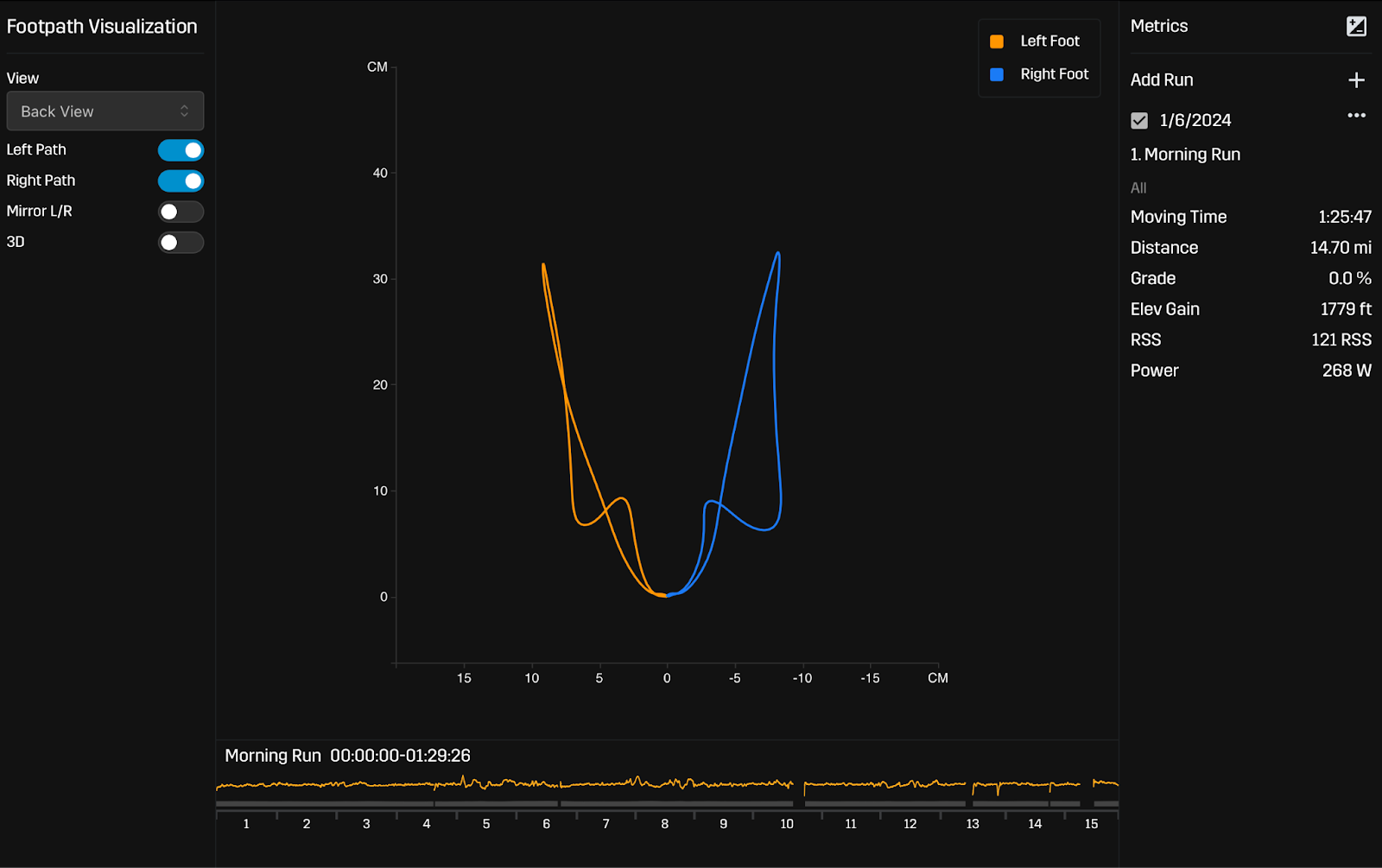
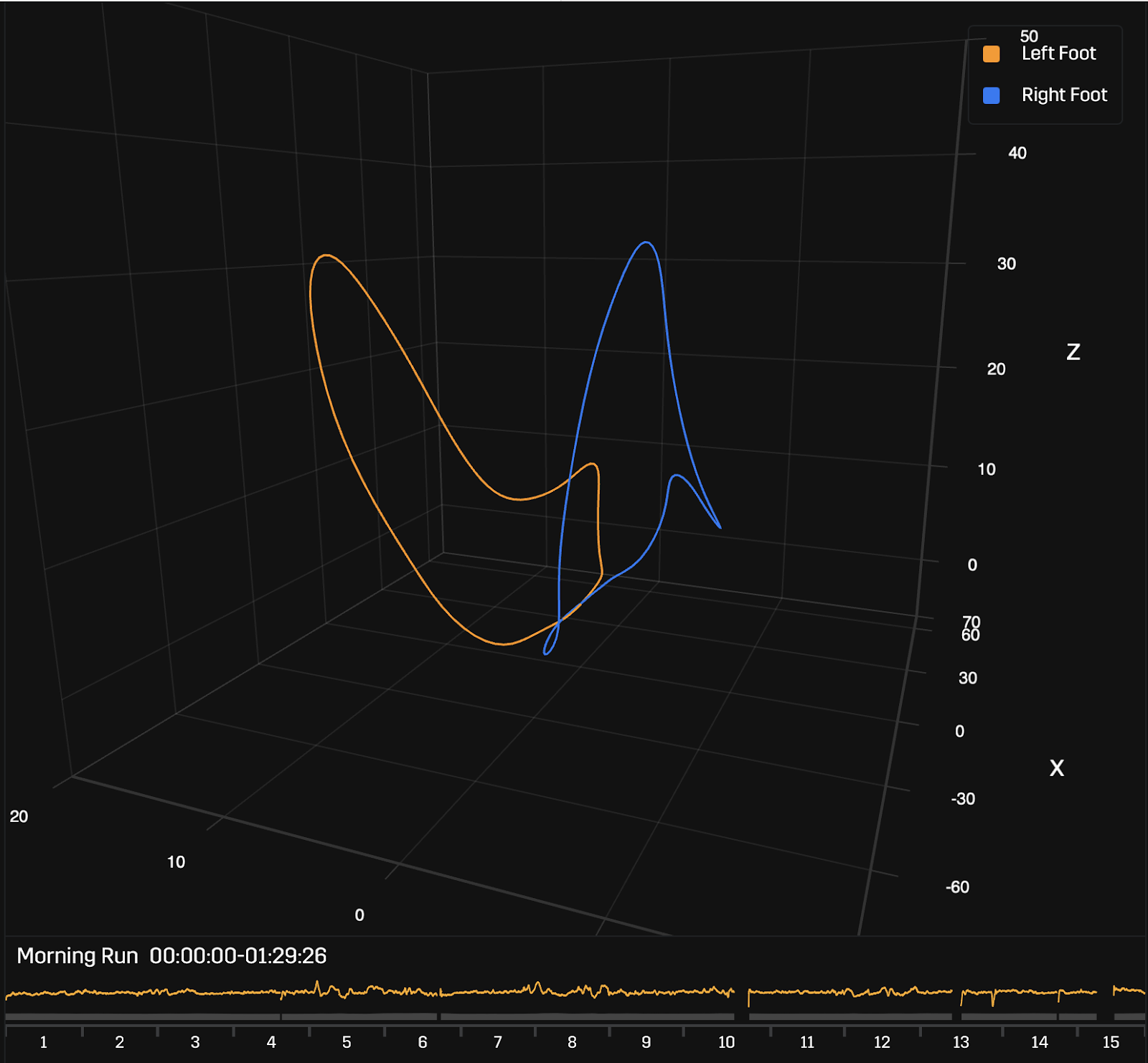
Mike has pointed out a lot about how you can tell what’s an uphill and downhill from the Footpath outputs (in Chicagoland, that’s much less of a concern - though at least my new suburban home has some hills!) and the ability to “track” injuries and pains over time. It’s the latter that really stands out to be - and is probably something Stryd, in their data-driven pursuit, is hesitant to say too much about without further backing.
Let me try a very simple comparison of this - I pulled up my Strava (follow, for more useless ramblings) and searched “Achilles” to try and pinpoint a particularly painful run. The worse, the better, for this exercise (note that this particular search pulled up 100 exercises… and doesn’t even include variations on the term!). In general, the pain is on my left side. Here’s one - November 25, 2023 - 13.92 miles in the Nike Vomero 25, where I complained specifically about (and remember vividly!) Achilles discomfort. Now, I know that lately my Achilles has been feeling much better, so I pulled up a more recent effort (1/6/2024, 14.76 miles in the Atreyu Base Model) and compared them. These two runs were almost exactly on the same route - the January run had an extension of a mile, and I came back on a different road (with similar elevation).
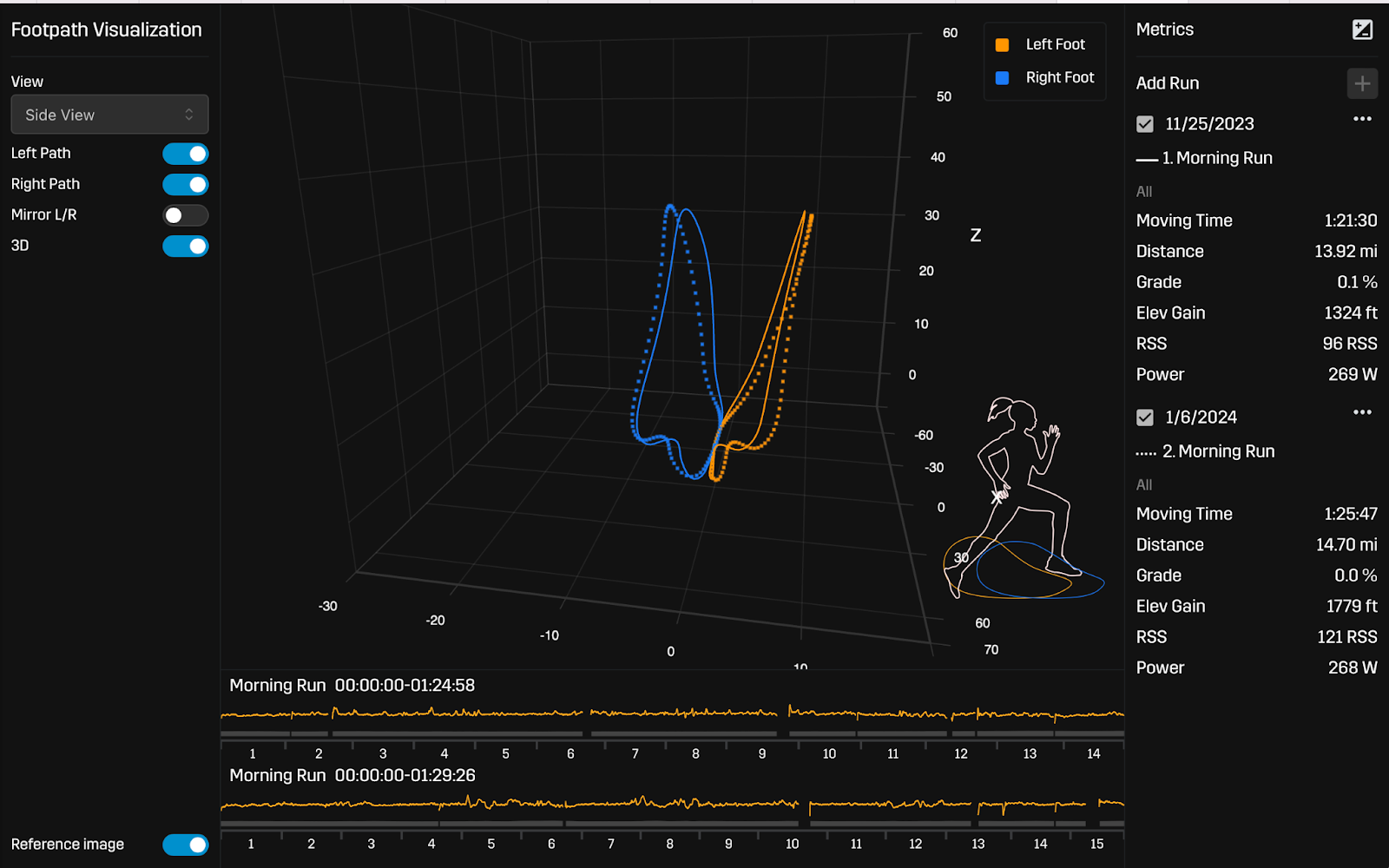
Doted Lines November 23 Vomero run with Achilles issue, Solid Lines January 6
These are both outdoor runs, with very similar power - and it was interesting to see just how similar they were, in this 3D visualizer. I remember both runs really well, and while I can zoom in and find areas where the two flight paths differ, it’s clear to me that both runs are more similar than different. And that makes sense - both runs were quite quick (5:53 and 5:51 per mile averages, respectively) - and I’ve long thought that your footstrike necessarily “tightens up” (homogenizes) when running faster. Less room for error, less leeway in lateral motion - and this seems to confirm that. Could I tell, without working backwards, which run was more painful and which less? I could not (though I can make deductions, already knowing the answer). There’s more stray motion in the Vomero run, but it’s slight.

Doted Lines November 23 Vomero run with Achilles issue, Solid Lines January 6
Even more useful would be taking this data, and comparing it against which shoe you’re wearing, to evaluate which shoe provides the most pain-free, efficient, and powerful (using Stryd’s classic power methodology!) running form. That’s perhaps harder for us shoe-reviewing-types, who cycle shoes extensively, but it’s something that I imagine would be massively useful for those who are trying to pick Alphafly vs. Vaporfly, or elite runners looking for that true edge. We’re at the beginning of this analysis here, not the middle (and certainly not the end) and I’m just so excited to see this much data being available to regular consumers at a reasonable cost.
I mentioned it above so I will note only very quickly that Stryd once again remains the gold-standard for treadmill pace and distance tracking; I’ve actually noticed that, whether it’s my treadmill or the accuracy of the pods, you can actually see how the treadmill belt slows down (under load) and speeds up (with no foot contact) and how the foot pod picks that up. Frankly. I think Stryd or Strava would be better off smoothing it for clarity’s sake, but hey - you can tell it’s really recording frequently! As long as I have a treadmill, I will have a Stryd - the hyper-accurate recording is absolutely my favorite feature of the device.

Conclusions
Mike P: So, is the Stryd Duo setup worth it? No doubt, it’s a significant investment. I’m seeing the listed price currently at $249 for a single Next Gen pod (you need 2 pods for a Duo setup). But I’m also seeing pricing for 2 pods at $299, plus a 12 month subscription commitment at $9.99 per month, for a total of $419. If you are at all interested in the features provided by Stryd, and most significantly the (now 3D) footpath visualization features - I’d say that’s a reasonable price to get two pods on your feet and have access to the full feature set for 1 full year.
Note: Stryd Membership is required for viewing and analyzing Stryd Footpaths, however membership is not required for storing Stryd Footpaths nor is it required for storing, viewing, or analyzing new Stryd Duo balance metrics. Subscribe at any time to view and analyze previously stored Stryd Footpaths.
Just think about how much we spend as runners on gear, races, hydration & nutrition, watches (!), as well as other tech. With the Stryd Duo, you really do get groundbreaking technology that you can’t get anywhere else. Something else to ponder - how much would a single-session video stride/gait analysis cost - if you could even find something like that?
Of course you may respond- having the data and looking at the data is one thing, but it’s still very unclear what actionable steps you can take with that data to improve your running. After all, isn’t that the end game here?
I do have to mention that although the rollout of the new Stryd Duo features wasn’t the smoothest, part of the reason for that was the constant new features that Stryd is actively rolling out. The 3D visualization was just released this past week, partly in response to user feedback. To that end, Stryd has vaguely promised exciting updates and features in the pipeline as it relates to data analysis and guidance. As you can imagine, this is probably the #1 topic that users ask about.
Ultimately, as far as the Duo setup goes - as with any new tech, it’s up to you how much you’re willing to spend. I would 100% still recommend a single Next Gen Stryd pod for virtually every runner. The basic accuracy benefits of the Stryd pod as well as the power metrics are extremely valuable. The Duo setup - specifically, needing a monthly subscription to view the Footpaths, is a bit of a stretch though.
For me, the value of the Duo setup is really dependent on being able to view the Footpaths in conjunction with the metric data (which is provided without subscription). But adding an additional recurring fee on top of - no doubt, the many subscriptions that everyone already has, is a tough one to swallow. At least they do store the data so perhaps it’s something you can activate and key in on during specific periods?
Final note - there are so many features and threads to pull in this analysis. I realize I’ve left many things out. I tried to focus on the things that stood out and were most important to me. Please go back to our review from last year for the more general review of Power-based running, Critical Power, Race Predictors, etc. Feel free to fire away in the comments if there’s anything else you’d like to hear about! Thanks for reading.
Michael: As runners, there’s just something so fun about the ability to collect data, whether we use it or not. We’re always upgrading to the latest and greatest GPS wearable, heart rate monitor, footpod - trying to see whether this compilation of numbers and signals can get us some tangible benefit. For some of us, that’s staying injury-free (or recovering from an existing one!) and for others, it’s getting faster or more efficient. So many times, I’ve looked at this data coming from my watch or footpod, and ultimately reached the same conclusion - this isn’t really that useful. With Duo and Footpath, I think we’ve changed that.
Let me add my usual caveats here - Stryd’s next big leap is not enough to make me say you need to go out and buy a footpod (or two) today (or tomorrow). It’s not there yet, and I suspect it won’t be fully there in 2024, either, even as Stryd continues to add useful tools. But if you’re a data nerd (maybe an ex-RunScribe+ user, eh?) who is interested in running mechanics, running power, and just all-around bettering runner performance, I do think the new Stryd setup is one that should be on your immediate radar. If you run even occasionally on a treadmill, I wholeheartedly and vocally think you should have a single Stryd pod. Full stop. And if you have one (especially if you have one, and pay the subscription plan already), it’s not such a big leap to add the second pod and unlock the Duo feature set.
One of my rotated tech review sites, The Verge, has a saying - “Never buy hardware today based on a promise of software tomorrow” (see their article regarding the iPad Pro, for more). Undoubtedly, we’re tipping into that territory here. But in my opinion, there’s enough software here (and some undoubtedly great hardware!) that I think you can feel justified in making the initial investment, getting some benefit from the pods (especially if you’re a treadmill runner) and keeping faith in Stryd that even more utility is coming. After all, who else is making such cool running-related gadgets?
Stryd Duo + Stryd Footpath is available from Stryd HERE
Mike Postaski currently focuses on long mountainous ultras - anywhere from 50K up to his favorite - 100M. 5'10", 138 lbs, midfoot/forefoot striker - he typically averages 70 mpw (mostly on trails), ramping up to 100+ mpw during race buildups. A recent 2:39 road marathoner, his easy running pace ranges from 7:30 - 9:00/mi. From 2022-23 Mike has won the Standhope 100M, IMTUF 100M, and Scout Mountain 100M trail ultras. He also set a CR of 123.74M at the Pulse Endurance Runs 24H and completed the Boise Trails Challenge on foot in 3 days 13 hours, besting the previous record by 7 hours. Mike's shoe preferences lean towards firmer, dense cushioning, and shoes with narrower profiles. He prefers extra forefoot space, especially for long ultras, and he strongly dislikes pointy toe boxes.
Michael is a patent attorney and graduate of Northwestern University Law School. Prior to law school, he competed collegiately at Washington University in St. Louis (10,000m PR of 30:21). Michael’s PRs include a 67:43 half-marathon (Chicago Half-Marathon) and a 2:21:19 marathon PR at the 2023 Grandma’s Marathon. Michael continues to race on the roads, and is chasing a sub-2:20 marathon and potential OTQ in the future.
Samples (and subscriptions) were provided at no charge for review purposes with no other compensation from Stryd. RoadTrail Run has affiliate partnerships and may earn commission on products purchased via shopping links in this article. These partnerships do not influence our editorial content. The opinions herein are entirely the authors'.
Comments and Questions Welcome Below! Please let us know mileage, paces, race distances
Find all RoadTrailRun reviews at our index page HERE
RoadTrailRun Official Store Custom Fractel Caps and Bucket Hats
Cap:$39 Bucket:$49






